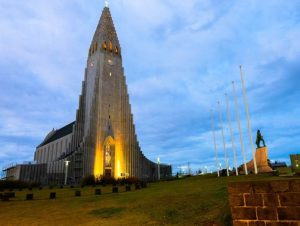Hallgrímskirkja is a Lutheran (Church of Iceland) parish church in Reykjavík, Iceland. At 74.5 meters tall, it is the largest church in Iceland and among the tallest structures in the country. The church is named after the Icelandic poet and cleric Hallgrímur Pétursson, author of the Passion Hymns.

Situated on the hilltop Skólavörðuholt near the center of Reykjavík, the church is one of the city’s best-known landmarks and is visible throughout the city. State Architect Guðjón Samúelsson’s design of the church was commissioned in 1937. He is said to have designed it to resemble the trap rocks, mountains, and glaciers of Iceland’s landscape, in particular, its columnar basalt “organ pipe” formations.

Architecturally, Hallgrímskirkja consists of three parts: The tower with the distinctly curved side wings that house service facilities, a nave in more traditional architecture, and a sanctuary at the other end of the nave, whose cylindrical shape has been described as evoking Viking war helmets.
It took 41 years to build the church: construction started in 1945 and ended in 1986, but the landmark tower was completed long before the whole church was finished. The crypt beneath the choir was consecrated in 1948, the steeple and wings were completed in 1974, and the nave was consecrated in 1986. The interior is 1,676 square meters.

The church houses a large pipe organ by the German organ builder Johannes Klais of Bonn. It has mechanical action, four manuals and pedals, 102 ranks, 72 stops, and 5275 pipes. It is 15 meters tall and weighs 25 tons. Its construction was finished in December 1992. It has been recorded by Christopher Herrick in his Organ Fireworks VII CD.
The church is also used as an observation tower. An observer can take a lift up to the viewing deck and view Reykjavik and the surrounding mountains.

It also serves as a focal meeting point for several cultural events, such as the annual gathering for watching the fireworks on New Year’s Eve. On this night, thousands of people set off dozens of fireworks in an ad-hoc, somewhat chaotic, yet unbelievably dazzling show.
In the lead-up to the night, many shops sell protective goggles that are recommended for all observers, particularly children, due to a few incidents of debris falling from poorly aimed fireworks.
According to Wikipedia















